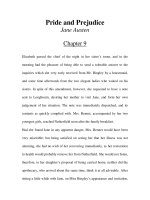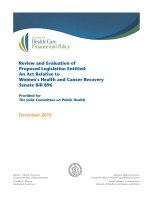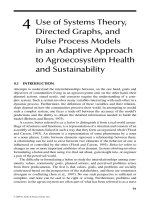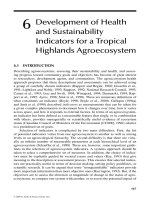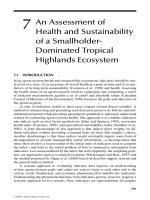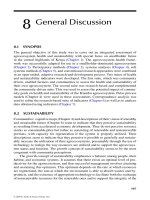Integrated Assessment of Health and Sustainability of Agroecosystems - Chapter 9 pdf
Bạn đang xem bản rút gọn của tài liệu. Xem và tải ngay bản đầy đủ của tài liệu tại đây (135.8 KB, 2 trang )
203
9
General Conclusions
1. This work demonstrates that a holistic approach to investigating agroeco-
system health (AESH) and beginning to implement sustainable processes
for AESH improvement is feasible even with complex eld situations.
2. Communities were able to use the concept of health to discuss and model
approaches to improve their livelihoods. The approach provides a simple, yet
highly specialized language—understood by the communities, researchers,
extension agents, development agents, and policymakers—for discussing
issues relating to AESH and sustainability.
3. Although remarkably similar to traditional methods of integrated commu-
nity development, the AESH framework is based on the principles of sys-
tems theory and practice, participatory and action research methods, and
conventional research methods combined into a transdisciplinary frame-
work. The AESH framework as applied in this study is a metaphor to struc-
ture how people think about their actions—social or economic—and their
implication on the biophysical world to improve their own well-being and
to conserve the natural resource base on which their survival depends.
4. A unique feature in this process was that communities, researchers, and
development agents played complementary roles. While the communities’
role was crucial to understanding the system and in dening the criteria
for health, the role of the researchers as experts in methods and that of the
development and extension agent as subject experts was critical to the over-
all success of the project.
5. Cognitive maps, graph theory, and pulse process models were useful in
analyzing community perceptions of factors that inuence AESH and sus-
tainability. That communities easily understood and applied cognitive maps
to depict their perceptions combined with the fact that the cognitive maps
were largely in agreement with ndings from the participatory workshops
indicate the potential of this method. In an action research process, cogni-
tive maps can be reevaluated and updated in each action research cycle
as the local theory develops. In this way, they can serve as a record of the
developing local theory, an analytical tool, and a means for assessing new
goals and objectives.
6. Rich pictures were useful in helping communities to analyze the different
perspectives that existed on a problem situation and in guiding consensus
building, negotiation, and compromise.
7. Communities used the information derived using indicators to reevaluate their
action plans, objectives, and goals. This demonstrates the success of the AESH
approach in operationalizing the concepts of AESH and sustainability and in
incorporating them into the decision-making processes of the communities.
© 2009 by Taylor & Francis Group, LLC
204 Integrated Assessment of Health and Sustainability of Agroecosystems
8. Technical improvements, such as geographical information systems and
remote sensing, self-reporting systems, and automated and integrated com-
puter-based data-gathering techniques, would be needed to make indicator
data more reliable and cost-effective in the long term.
9. Both community-driven and researcher-based indicators were useful
because the two suites provided complementary but fundamentally differ-
ent information. Because communities often lack the capacity to develop
and measure quantitative indicators, while researchers and policymakers
lack the knowledge and mandate to make value-based judgments, it seems
that decision support systems for such integrated and adaptive approaches
as sustainability and AESH should include both components to provide a
balanced assessment.
10. MCA (multiple correspondence analysis) was useful in summarizing and
presenting indicator data for two reasons: (1) the incorporation of targets
and thresholds in the process of categorizing the indicators, thus providing
an intuitive interpretation, and (2) projection of data from the initial and
subsequent measurements into a multidimensional space.
© 2009 by Taylor & Francis Group, LLC
